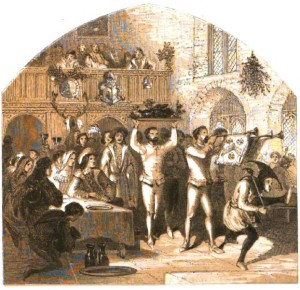
Bringing in the Boar’s Head, which was the first dish served at ceremonial meals at Christmastime in England as early as 1170.
At Christmastide in 1340 England, a young scholar named John Copcot strolled through Shotover Forest on his way to St. Giles Church in the village of Horspath from Queen’s College in Oxford in order to attend Christmas Mass. As he strolled he perused his studies of the Greek philosopher Aristotle. Suddenly he looked up to see a wild boar running to attack him. Its mouth was open wide, with bristling sharp teeth and enormous tusk. Intuitively young Copcot shoved his metal bound volume into the open jaws of the beast, literally choking the animal to death. Then nonchalantly, the scholar severed the head of the beast, stuck it to the tip of his spear, and continued on to church. Once there, he left the spear and boar’s head at the door, entered the sanctuary and participated in the Christmas mass. Afterwards, he picked up the spear, returned to Queen’s College where the boar’s head was cooked and served.
Thus began a centuries old Christmas tradition in England and later the United States. However, the serving of the Boar’s Head was celebrated as early as 1170 by King Henry II and even earlier according to Greek and Roman mythologies. It was the first dish served at ceremonial meals. Since the king owned all the forests in England at the time only he and his peers were able to hunt wild life. By the 13th century, wild boars were extinct in England; so did Copcot really kill one in Shotover Forest in 1340? Who knows?
But the celebration has continued over centuries. Earlier this month, I was fortunate to attend The Boar’s Head and Yule Log Festival at University Christian Church in Fort Worth. It was a beautiful celebration that focused on the meaning of Christmas in music, drama, and dance. The entire membership of the congregation participated.
I felt like I was at Queen’s College attending the ancient Boar’s Head and Yule Log Festival there. The costumes were authentic, the music was superb, the children were so special, and even the village dogs were well behaved. It was a very unique ending to the Christmas season.
About a year ago, I participated in DNA testing. My results showed that 69% of my genetic background is Great Britain and 11% is Europe West. That agrees with my research; most of my ancestors were from Great Britain, but not Scotland or Ireland, and one family line migrated to the Colonies in 1751 from the Germanic states. So, as I sat in University Christian Church in Fort Worth one Saturday in January 2015, I wondered if any of my ancestors had participated in a Boar’s Head and Yule Log Festival. My calculations indicate that all were in North America by 1800 and probably by the time of the American Revolution.
Many of the participants were dressed as commoners. There were cooks, and hunters, and children, and dogs. It was like a village celebration of the Christmas season. Yet, my research (online) indicated that this festival was limited to kings, lords, scholars, and others of the Downton Abbey upstairs caste. Could some of my ancestors have lived in a village and participated in such a celebration? I would like to think so.
